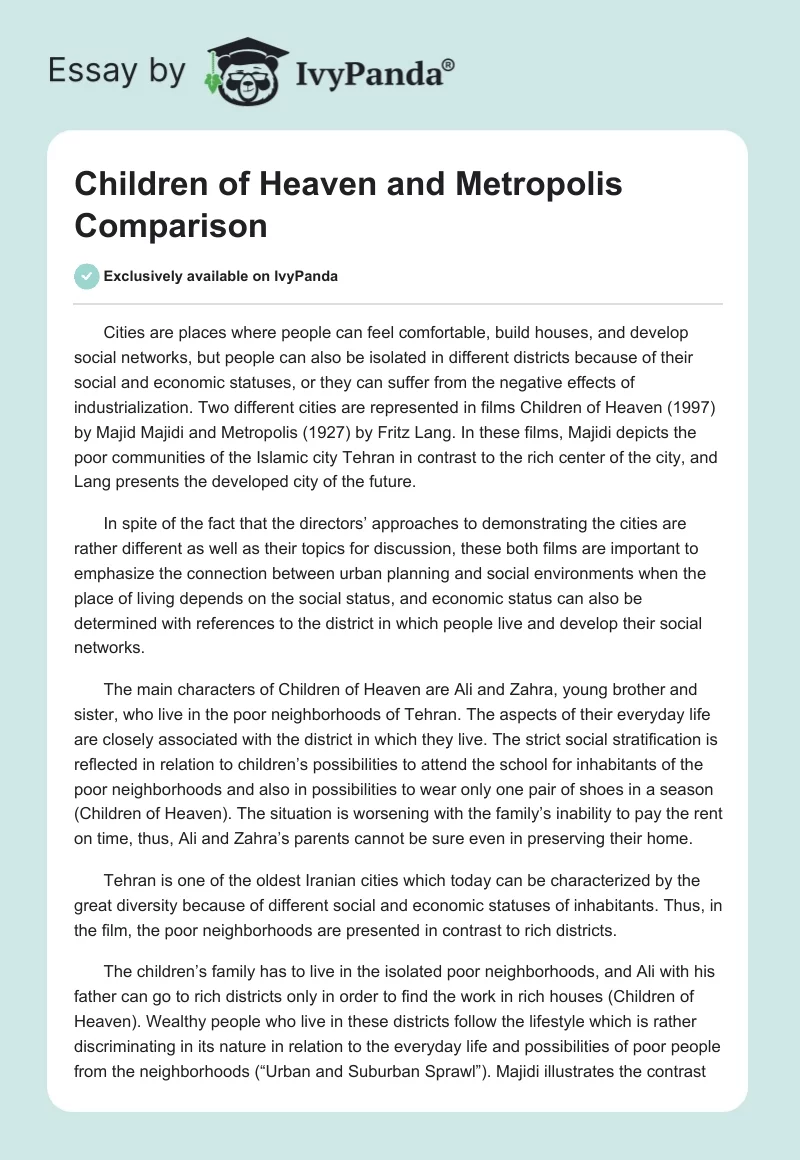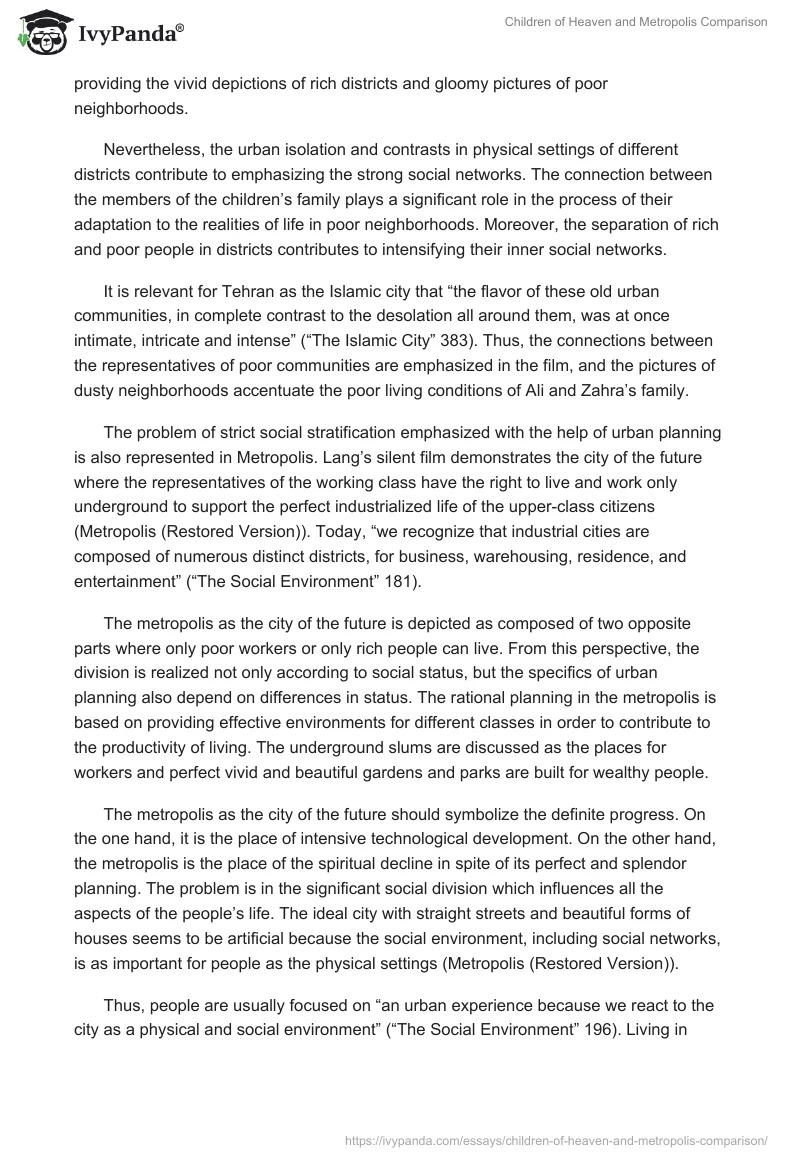Cities are places where people can feel comfortable, build houses, and develop social networks, but people can also be isolated in different districts because of their social and economic statuses, or they can suffer from the negative effects of industrialization. Two different cities are represented in films Children of Heaven (1997) by Majid Majidi and Metropolis (1927) by Fritz Lang. In these films, Majidi depicts the poor communities of the Islamic city Tehran in contrast to the rich center of the city, and Lang presents the developed city of the future.
In spite of the fact that the directors’ approaches to demonstrating the cities are rather different as well as their topics for discussion, these both films are important to emphasize the connection between urban planning and social environments when the place of living depends on the social status, and economic status can also be determined with references to the district in which people live and develop their social networks.
The main characters of Children of Heaven are Ali and Zahra, young brother and sister, who live in the poor neighborhoods of Tehran. The aspects of their everyday life are closely associated with the district in which they live. The strict social stratification is reflected in relation to children’s possibilities to attend the school for inhabitants of the poor neighborhoods and also in possibilities to wear only one pair of shoes in a season (Children of Heaven). The situation is worsening with the family’s inability to pay the rent on time, thus, Ali and Zahra’s parents cannot be sure even in preserving their home.
Tehran is one of the oldest Iranian cities which today can be characterized by the great diversity because of different social and economic statuses of inhabitants. Thus, in the film, the poor neighborhoods are presented in contrast to rich districts.
The children’s family has to live in the isolated poor neighborhoods, and Ali with his father can go to rich districts only in order to find the work in rich houses (Children of Heaven). Wealthy people who live in these districts follow the lifestyle which is rather discriminating in its nature in relation to the everyday life and possibilities of poor people from the neighborhoods (“Urban and Suburban Sprawl”). Majidi illustrates the contrast providing the vivid depictions of rich districts and gloomy pictures of poor neighborhoods.
Nevertheless, the urban isolation and contrasts in physical settings of different districts contribute to emphasizing the strong social networks. The connection between the members of the children’s family plays a significant role in the process of their adaptation to the realities of life in poor neighborhoods. Moreover, the separation of rich and poor people in districts contributes to intensifying their inner social networks.
It is relevant for Tehran as the Islamic city that “the flavor of these old urban communities, in complete contrast to the desolation all around them, was at once intimate, intricate and intense” (“The Islamic City” 383). Thus, the connections between the representatives of poor communities are emphasized in the film, and the pictures of dusty neighborhoods accentuate the poor living conditions of Ali and Zahra’s family.
The problem of strict social stratification emphasized with the help of urban planning is also represented in Metropolis. Lang’s silent film demonstrates the city of the future where the representatives of the working class have the right to live and work only underground to support the perfect industrialized life of the upper-class citizens (Metropolis (Restored Version)). Today, “we recognize that industrial cities are composed of numerous distinct districts, for business, warehousing, residence, and entertainment” (“The Social Environment” 181).
The metropolis as the city of the future is depicted as composed of two opposite parts where only poor workers or only rich people can live. From this perspective, the division is realized not only according to social status, but the specifics of urban planning also depend on differences in status. The rational planning in the metropolis is based on providing effective environments for different classes in order to contribute to the productivity of living. The underground slums are discussed as the places for workers and perfect vivid and beautiful gardens and parks are built for wealthy people.
The metropolis as the city of the future should symbolize the definite progress. On the one hand, it is the place of intensive technological development. On the other hand, the metropolis is the place of the spiritual decline in spite of its perfect and splendor planning. The problem is in the significant social division which influences all the aspects of the people’s life. The ideal city with straight streets and beautiful forms of houses seems to be artificial because the social environment, including social networks, is as important for people as the physical settings (Metropolis (Restored Version)).
Thus, people are usually focused on “an urban experience because we react to the city as a physical and social environment” (“The Social Environment” 196). Living in isolated districts and parts of the city, people have to live in specific micro-environments where life can develop according to the rules other than in different parts of the city.
The problem is in the fact that poor or working people rarely receive the opportunities to break the social rules typical for their neighborhoods and communities in order to choose another place to live and build their networks. For instance, those workers who live in the underground slums in the metropolis cannot join the upper districts of the city because it is the place for rich people.
The poor neighborhoods depicted in Children of Heaven by Majid Majidi and underground slums presented Metropolis by Fritz Lang are the vivid examples of the isolated territories in cities the life in which is characterized by special rules and norms. Moreover, the values and beliefs shared by the representatives of these districts can differ significantly from the ideals of upper-class representatives who live or work in the central parts of cities.
Nevertheless, the effects of living in poor conditions and environments are not always negative. It is accentuated in Children of Heaven, that the main wealth which people can have is not material, it is a deep connection in a family.
This idea is reflected in Metropolis in relation to the lack of spirituality in the perfect technological world where all the elements are carefully planned and designed. Those people who live in isolated environments use the other forces to motivate themselves, as a result, the impact of the city life on persons can be different. Furthermore, the people’s images of the city and their mental maps depend significantly on the specific social and physical environments.
Works Cited
Children of Heaven. Ex. Prod. Amir Esfandiari. Iran: The Institute for the Intellectual Development of Children & Young Adults. 1997. DVD.
Metropolis (Restored Version). Ex. Prod. Erich Pommer. Germany: UFA. 2010. DVD.
“The Islamic City”. Cities and Urban Life. Ed. John Macionis and Vincent Parrillo. USA: Prentice Hall, 2003. 380-385. Print.
“The Social Environment”. Cities and Urban Life. Ed. John Macionis and Vincent Parrillo. USA: Prentice Hall, 2003. 170-197. Print.
“Urban and Suburban Sprawl”. Cities and Urban Life. Ed. John Macionis and Vincent Parrillo. USA: Prentice Hall, 2003. 108-115. Print.


